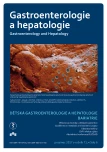Wilson’s disease in a cohort of pediatric patients in Slovakia
Authors:
J. Kosnáčová; Ľ. Podracká
Authors‘ workplace:
Detská klinika LF UK a DFNsP, Bratislava, Slovenská republika
Published in:
Gastroent Hepatol 2017; 71(6): 476-482
Category:
doi:
https://doi.org/10.14735/amgh2017476
Overview
Background:
Wilson’s disease (WD) is a rare, metabolic, genetically conditioned disease. Patients may be asymptomatic for varying periods of time or the disease may present with non-specific symptoms up to organ-specific disability. Diagnosis of the disease is confirmed by an analysis of clinical signs and the results of targeted examinations. If diagnosed early, the disease is treatable, with chelation therapy as the principal approach. Patients with acute liver failure are indicated for liver transplantation.
Material and Methods:
The authors retrospectively evaluate a group of 17 patients with WD diagnosed in childhood or adolescence.
Results:
WD was confirmed in 17 patients aged between 3 and 18 years at the 1st Pediatric Department of the Faculty of Medicine and Children’s University Hospital in Bratislava in the period from 2000 to 2015. The most common presentation of WD was in the liver (n = 13 patients; 77%). In two patients WD manifested with acute hepatic failure in adolescent age. Long-term increase in aminotransferase activity was detected in nine patients. In two patients we identified WD at the stage of cirrhosis. Neurological symptoms were observed in two patients. The most commonly confirmed genetic mutation in the Central European region, H1069Q, was confirmed in 6 homozygous carriers, while 10 patients were compound heterozygous carriers. In one patient, pathological mutation could not be confirmed even by extensive genetic testing. Three patients from the cohort of 17 children underwent liver transplantation, 2 asymptomatic children are treated with zinc, 11 patients are treated with penicillamine, and 1 patient with trientine dihydrochloride.
Conclusion:
WD is a rare childhood disease. Its most common manifestation is the hepatic form in the second decennium. Establishing the diagnosis may be very challenging. There is no single highly sensitive and specific parameter clearly pointing to the diagnosis. Serum ceruloplasmin level is the primary screening test. Plasma levels of copper and renal excretion of copper serve as auxiliary examinations. The gold standard for confirming the diagnosis is to determine copper concentrations in the liver in dried liver tissue. Genetic testing is of benefit when confirming the diagnosis of WD, particularly in first-degree relatives, asymptomatic individuals. Early diagnosis and treatment can prevent progression of the disease. If left untreated, the disease is fatal.
Key words:
Wilson’s disease – copper – ceruloplasmin – copper in dried liver tissue
The Editorial Board declares that the manuscript met the ICMJE „uniform requirements“ for biomedical papers.
The authors declare they have no potential conflicts of interest concerning drugs, products, or services used in the study.
Submitted:
23. 10. 2017
Accepted:
4. 12. 2017
Sources
1. Tanner S. Disorders of copper metabolism. In: Kelly DA. Diseases of the liver and biliary system in children. Oxford: Blackwell Science 2004 : 328.
2. The Human Gene Mutation Database. Gene Symbol. [online]. Available from: http: //www.hgmd.cf.ac.uk/ac/gene.php?gene=ATP7B.
3. Naorniakowska M, Dądalski M, Kamińska D et al. Clinical presentations of Wilson disease among Polish children. Dev Period Med 2016; 20 (3): 216–221.
4. Møller LB, Horn N, Jeppesen TD et al. Clinical presentation and mutations in Danish patients with Wilson disease. Eur J Hum Genet 2011; 19 (9): 935–941. doi: 10.1038/ejhg.2011.80.
5. Vrabelova S, Letocha O, Borsky M et al. Mutation analysis of the ATP7B gene and genotype/phenotype correlation in 227 patients with Wilson disease. Mol Genet Metab 2005; 86 (1–2): 277–285.
6. Mareček Z. Současné možnosti diagnostiky a léčby Wilsonovy choroby. Prakt Lék 2007; 87 (1): 17–22.
7. Procházková D. Diagnostika a terapie dědičných poruch metabolizmu. Wilsonova choroba. Brno: Masarykova univerzita 2004.
8. Schilsky ML. Wilson disease. Current status and the future. Biochemie 2009; 91 : 1278–1281. doi: 10.1016/j.biochi.2009. 07.012.
9. Roberts EA, Schilsky ML. Diagnosis and treatment of Wilson disease: an update. Hepatology 2008; 47 (6): 2089–2111. doi: 10.1002/hep.22261.
10. Coffey AJ, Durkie M, Hague S. A genetic study of Wilson’s disease in the United Kingdom. Brain 2013; 136 (Pt 5): 1476–1487. doi: 10.1093/brain/awt035.
11. Litwin T, Gromadzka G, Członkowska A. Gender differences in Wilson’s disease. J Neurol Sci 2012; 312 (1–2): 31–35. doi: 10.1016/j.jns.2011.08.028.
12. European Association for Study of Liver. EASL Clinical Practice Guidelines: Wilson’s disease. J Hepatol 2012; 56 (3): 671–685. doi: 10.1016/j.jhep.2011.11. 007.
13. Sócio S, Ferreira AR, Fagundes ED et al. Wilson’s disease in children and adolescents: diagnosis and treatment. Rev Paul Pediatr 2010; 28 (2): 134–140.
14. Kumar MK, Kumar V, Singh PK et al. Wilson’s disease with neurological presentation, without hepatic involvement in two siblings. J Clin Diagn Res 2013; 7 (7): 1476–1478. doi: 10.7860/JCDR/2013/ 5974.3188.
15. Caca K, Ferenci P, Kühn HJ et al. High prevalence of the H1069Q mutation in East German patients with Wilson disease: rapid detection of mutations by limited sequencing and phenotype-genotype analysis. J Hepatol 2001; 35 (5): 575–581.
16. Ferenci P, Caca K, Loudianos G at al. Diagnosis and phenotypic classification of Wilson disease. Liver Int 2003; 23 (3): 139–142.
17. Sternlieb I. Perspectives on Wilson’s disease. Hepatology 1990; 12 (5): 1234–1239.
18. Kosnáčová J, Podracká Ľ, Hornová J. Výsledky transplantácií pečene u slovenských detí. Gastroent Hepatol 2015; 69 (6): 541–546. doi: 10.14735/amgh2015541.
19. Procházková D, Konečná P, Vrábelová S et al. Význam molekulárně-genetického vyšetření pro diagnostiku Wilsonove choroby. Čes-slov Pediat 2005; 60 (4): 188–199.
20. Dhawan A, Taylor RM, Cheeseman P et al. Wilson’s disease in children: 37-year experience and revised King’s score for liver transplantation. Liver Transpl 2005; 11 (4): 441–448.
Labels
Paediatric gastroenterology Gastroenterology and hepatology SurgeryArticle was published in
Gastroenterology and Hepatology

2017 Issue 6
Most read in this issue
- Cytomegalovirus infection and the liver
- Magnesium sulfate saline laxatives in the preparation for colonoscopy – our experience
- Epidemiology, hospitalization and migration of patients with IBD under specialized care in the Czech Republic
- Obesity and kidney
